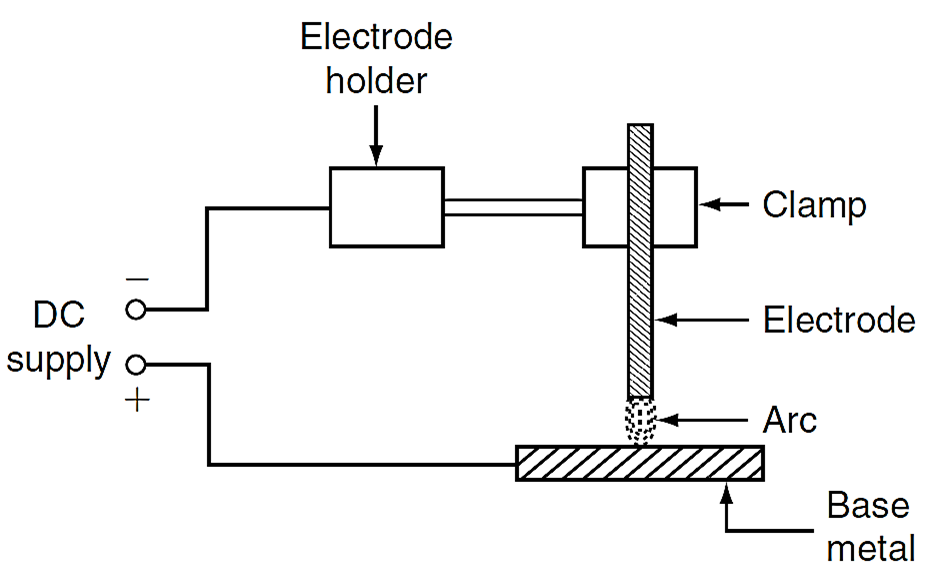Carbon Arc Welding (CAW) is a welding process that uses an arc struck between a carbon electrode and the base metal to generate heat for melting and joining metals. It is one of the oldest welding processes, invented in 1881 by Nikolay Benardos.
The heat generated by the arc melts the base metal and, in some cases, filler material. Once cooled, the metals fuse together, creating a weld. This process is primarily used for joining non-ferrous metals and cast iron.

Working Principle of Carbon Arc Welding
In CAW, a direct current (DC) power source supplies energy to create an arc between a carbon electrode and the base metal. The arc generates intense heat (up to 3500°C), sufficient to melt the metal. The molten metal flows together and solidifies to form a strong joint.
Parts of Carbon Arc Welding Setup
- Power Supply (DC): Provides a steady current to maintain the arc. DC is preferred for better control over the arc. Polarity can be adjusted (straight or reverse) depending on the application.
- Carbon Electrode: Made of graphite or carbon, with or without copper coating for durability. Conducts electricity and generates heat by forming the arc.
- Electrode Holder: Holds the carbon electrode in position during welding.
- Clamp: Secures the workpiece to ensure stability.
- Base Metal: The material to be welded. Examples include non-ferrous metals and cast iron.
- Filler Rod (Optional): A rod used to add material to the weld joint if required.
- Protective Shield (Optional): Shielding gas or flux may be used to protect the weld pool from oxidation.
Carbon Arc Welding Process
Step-by-Step Procedure
- Preparation: Clean the base metal surface to remove contaminants like rust, oil, or dirt. Position the workpiece securely using clamps.
- Setting Up the Equipment: Attach the carbon electrode to the electrode holder. Connect the welding cables to the DC power source and set the desired current.
- Striking the Arc: Bring the carbon electrode close to the base metal to initiate the arc. Maintain a consistent gap (around 3-5 mm) between the electrode and the metal to stabilize the arc.
- Welding: Move the electrode along the joint at a steady speed. The arc generates heat, melting the base metal and, if needed, a filler rod.
- Cooling: Allow the molten metal to solidify, forming the weld joint. Post-weld treatments, such as cleaning or grinding, may be applied for a smooth finish.
Types of Carbon Arc Welding
- Single Carbon Arc Welding: Uses one carbon electrode to create the arc. Suitable for smaller welds and repair work.
- Twin Carbon Arc Welding: Employs two carbon electrodes to form the arc. Provides a more stable arc and greater heat control.
- Shielded Carbon Arc Welding: Involves using a shielding gas (e.g., argon or helium) or flux to protect the weld pool from contamination. Enhances weld quality and reduces oxidation.
Advantages of Carbon Arc Welding
- Simple Setup: Requires basic equipment, making it cost-effective and easy to use.
- Versatility: Can weld a variety of metals, including non-ferrous metals and cast iron.
- Good Control: Allows precise heat application, reducing the risk of warping.
- Filler Optional: Welding can be done with or without filler material, depending on the application.
- Low Operating Cost: Carbon electrodes are inexpensive and have a long service life.
- High Welding Speed: Suitable for quick repairs and small-scale applications.
Disadvantages of Carbon Arc Welding
- Limited Applications: Not ideal for thick materials or high-strength welds.
- Manual Operation: Requires skilled operators for consistent results.
- Low Efficiency: Heat loss is significant due to the open arc.
- No Flux: Without shielding gas or flux, the weld may be prone to oxidation and contamination.
- Limited Metal Types: Not effective for welding certain ferrous materials.
- Safety Concerns: High-intensity arc light and heat require protective gear to prevent injuries.
Applications of Carbon Arc Welding
- Repair Work: Ideal for repairing cast iron and non-ferrous metal components.
- Automotive Industry: Used for small-scale repairs and joining thin sheets.
- Electrical Industry: Commonly used for welding copper and aluminum conductors.
- Foundries: Employed in repairing casting defects.
- Aerospace: Suitable for welding lightweight non-ferrous materials like aluminum.
- Artistic Metalwork: Used for creating decorative pieces and sculptures.
Comparison with Other Welding Processes
| Feature | Carbon Arc Welding | TIG Welding | MIG Welding |
|---|---|---|---|
| Heat Source | Carbon Arc | Tungsten Arc | Consumable Wire |
| Shielding Gas | Optional | Required | Required |
| Metal Compatibility | Non-Ferrous, Cast Iron | All Metals | All Metals |
Safety Tips
- Protective Gear: Wear welding helmets, gloves, and aprons to shield against arc light and sparks.
- Ventilation: Ensure adequate ventilation to avoid inhaling fumes.
- Proper Handling: Securely clamp the workpiece to prevent movement during welding.
Conclusion
In summary, Carbon Arc Welding is a simple, versatile, and cost-effective process primarily used for non-ferrous metals and repair work. Despite its limitations, it remains valuable in industries requiring quick and straightforward welding solutions.